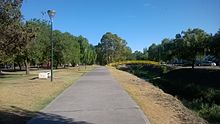Draft:Mayo Park (Parque de Mayo)
38°41′47″S 62°16′03″W / 38.69639°S 62.26750°W

Parque de Mayo (Mayo Park) is one of the most important green and recreational spaces in the city of Bahía Blanca, south of the province of Buenos Aires, Argentina.
It has an area of more than 60 forested hectares and has a health track, soccer field, softball field, an amphitheater, bicycle track, bike paths, children's games and an important artificial lake with fish and ducks through which you can see in two-seater pedal boats. Curved and zigzagging lines predominate in its layout, inviting you to walk through it and enter its landscape of eucalyptus trees inhabited by burrowing parrots.
HISTORY[edit]
The current Parque de Mayo in the city of Bahía Blanca owes its origin to a private initiative project by a group of neighbors who around 1906 began municipal presentations in order to carry it out. This project consisted of the construction of a neighborhood exclusively of chalets and extensive tree planting, similar to the alpine zone of Central Europe, located on the banks of the Napostá Stream.
For the project of the neighborhood, which due to its characteristics was unprecedented in Argentina and the first of its kind in South America, the Belgian architect and landscaper Augusto Flamant had been used and one third of the total surface had been transferred to the municipality with in order for it to be in charge of laying out and executing the park, lakes, general leveling of the land, demarcation of streets and avenues, as well as the planting of trees. Despite the commitment to build the chalets, these were not carried out and over time everything became a Municipal Park.
On December 25, 1906, the inauguration ceremony of the new park was celebrated and four years later, in 1910, its name was changed to Parque de Mayo , on the occasion of the first centenary of the May Revolution that was celebrated in Argentina.
In 1940, architect Manuel Mayer designed the Palihue Golf Club on the east side of the park, on the other side of the stream, and the adjacent development of the picturesque Barrio Parque Palihue satisfied the objectives of the initial park neighborhood project.



Coronel Ramón Bernabé Estomba Monument[edit]
As the date of the first centenary of the founding of Bahía Blanca approached, the need arose to honor Colonel Ramón Bernabé Estomba , who was its founder, by creating a memorial monument for him.
For this, they requested from the National Commission of Fine Arts a list of the five artists most qualified to carry out the work and granite blocks of exceptional quality from Germany were imported into the country, which arrived from Hamburg to the port of Ingeniero White aboard the steamer Lübeck. The collection, organized by the commission to cover the expenses of this monument, was one of the most important of that time in the city and the land on which the work is located was donated by the Commune inside the park.
The perfection and hardness of granite forced the sculptor Cesar Sforza to use electrical equipment to sculpt the bas-reliefs, being the first to use this system.
The Monument, with a height of 11 meters, is located on land donated by the Commune inside the Parque de Mayo. The granite pedestal is located on a circular platform and its volume decreases slightly as it rises. The corners of it are resolved by grooves. This base has four bas-reliefs: the one on the front symbolizes the conquest of the desert and the first farmers, on the right side you can see "The Harvesters", on the left side, an episode of "El Rodeo", and at the top "The dockworkers."
The crown of the monument is a statue cast in bronze, with five enormous figures that symbolize: the union of the precursors: the gaucho, the settlers (planting the first tree) and the soldier. The group is preceded by a woman, who represents national protection; She carries a flag, which shelters the national coat of arms under its folds.
